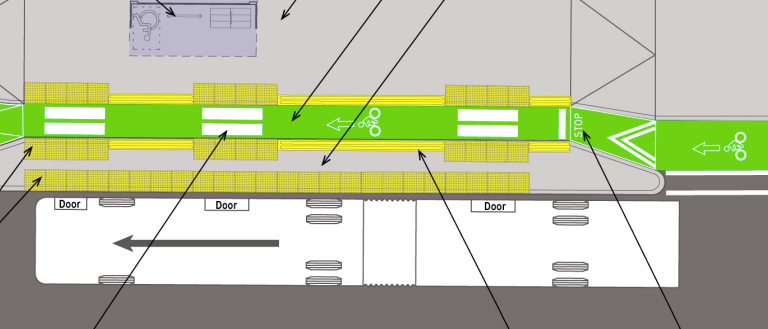
As TriMet inches ever closer to the final design of their $175 million Division Transit Project, the agency once again needs feedback on how best to handle bicycle users at new bus stations. And with protected bike lanes becoming a more common feature citywide, whatever TriMet decides to use could become the new standard.
Since our look at this project in October, TriMet has worked to “recalibrate” the project due to a budget shortfall of $14 million.
Several of the cost-cutting measures are based around station design. Instead of a raised island for passengers to wait on and bike lanes that jog behind it, the latest design would keep the bike lane in front of waiting passengers and offer a “step out” strip to be used just prior to boarding.
The design will be revealed for the first time at City Hall tonight at a special joint meeting of the PBOT’s Bicycle and Pedestrian Advisory Committees.
The update comes as TriMet reaches the 30 percent design milestone and looks to finalize the project by the end of next year. The Division Transit Project started in 2014 as a true bus rapid transit (BRT) line that would connect downtown Portland and Mount Hood Community College. But when it became clear that putting buses on state-controlled 82nd Avenue and/or dedicating lanes to them on SE Division wouldn’t be possible due to the presence of single-occupancy car drivers, the project stalled out.
In a FAQ published in August 2017, TriMet wrote that dedicated bus lanes weren’t possible because, “Division carries approximately 35,000 cars per day, which is well over the 20,000 to 25,000 cars per day that a 2- or 3-lane roadway can accommodate,” and that, “Reducing lanes on Division for a dedicated bus lane would very likely result in traffic diversion to other streets and significant delay.” Dedicated transit lanes would also prohibit some drivers from turning across them and the, “impacts to local access and vehicle circulation, including access to businesses,” were deemed too great.
Advertisement
Even without dedicated lanes, TriMet is promising 15-20 percent faster transit between Portland and Gresham thanks to upgrades in signal technology that will give buses priority, shorter “dwell times” (time buses spend at stops) thanks to all-door boarding and easier fare payment, fewer stops (one-third mile station spacing) and “demand based stops” where the operator will only stop if necessary. Of the 40 or so new platforms TriMet expects to build for this project, about 16 will be demand-based.
In a briefing with TriMet staff yesterday, we also learned they’ve finalized a contract with Union Pacific Railroad to upgrade track switches in the Brooklyn rail yard. This means delays caused by trains at the SE 8th crossing will be significantly minimized when the project is completed in May 2019 (well before the new line opens in 2022).
East of 82nd, PBOT’s concurrent Outer Division Safety Project project calls for a variety of protected bike lanes. Since those are relatively rare in Portland, TriMet has yet to standardize a bus stop design that preserves and respects biking space. TriMet hopes their new “Bikes Behind Step Out” design works well not only in the Division Transit Project, but throughout the city and region as well.
The design features a bike lane that narrows to three-feet wide as it enters the station area. One of TriMet’s big concerns is making sure bicycle users slow down and respect bus passengers. People will be expected to wait on one side of the bike lane; then when a bus arrives, they’ll step up to the small island before boarding. Bicycle users will be expected to stop and wait as buses load and unload.
Here’s a larger view of the new design:
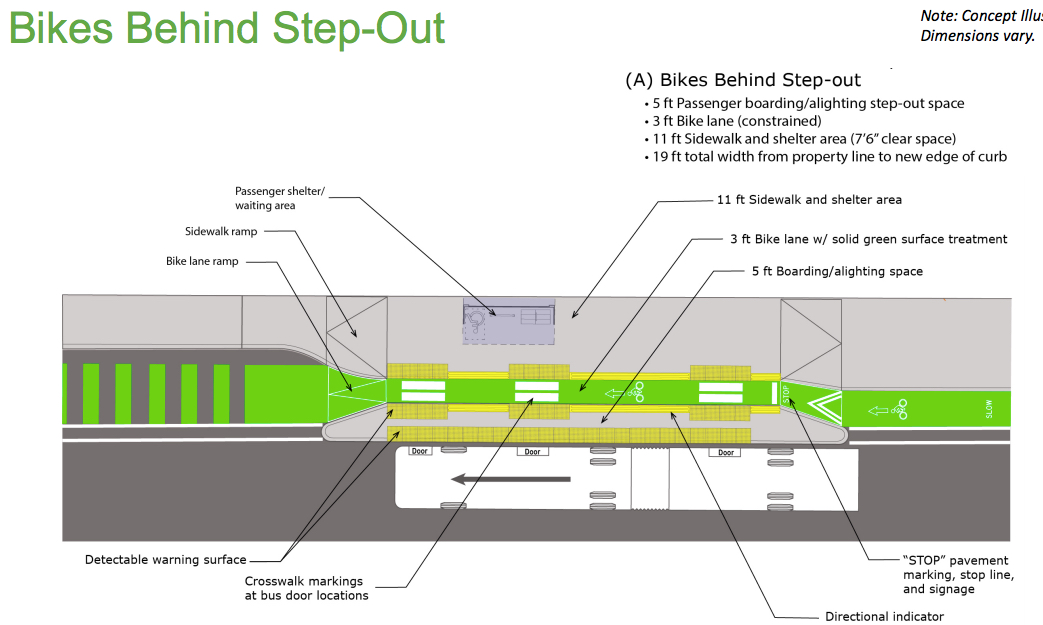
Consultants from Alta Planning and Design were hired to help create the design, which is best on best practices endorsed by the National Association of City Transportation Officials (NACTO). It’s preferred by TriMet because — unlike the initial islands design — the step out design has a smaller footprint and can use existing right-of-way (meaning, it’s cheaper).
TriMet compares their design to similar ones already in use in Toronto:
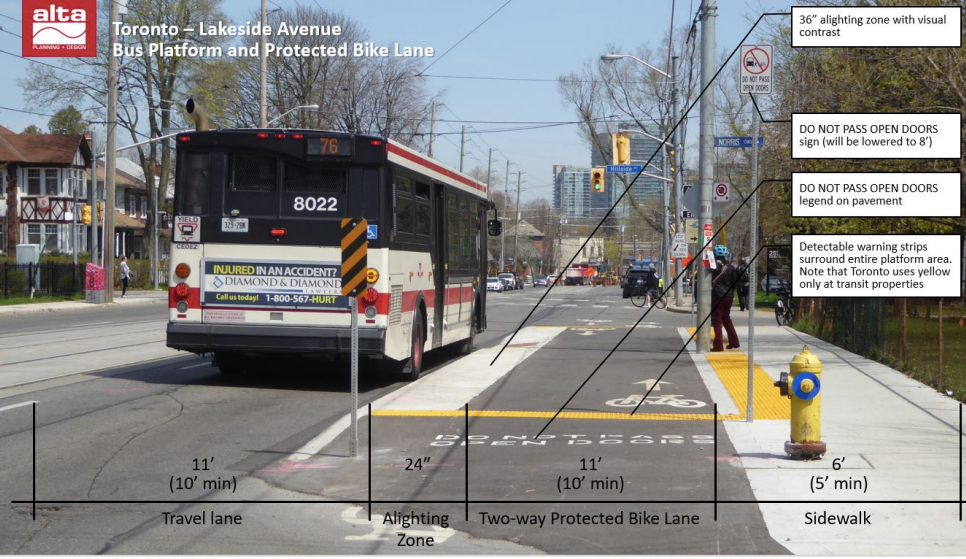
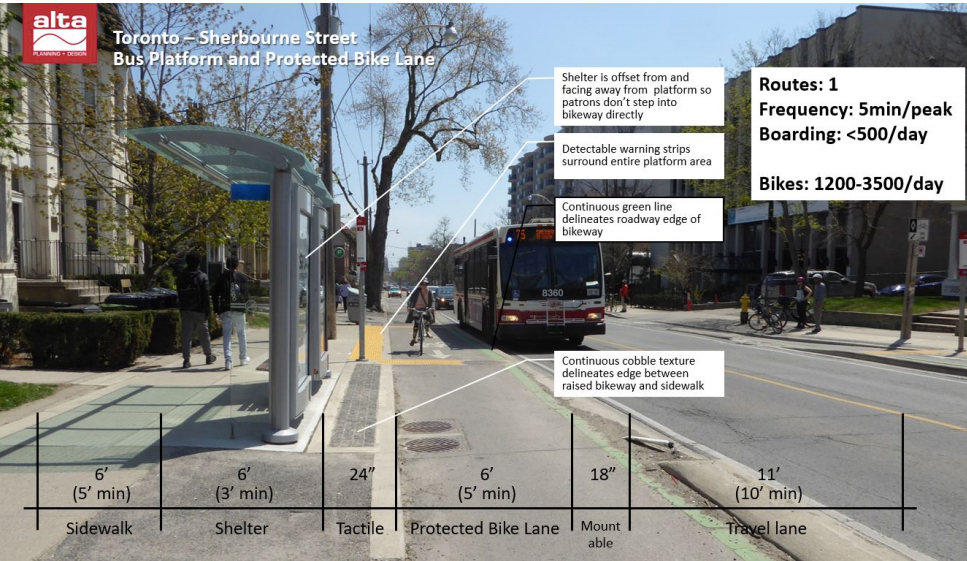
What do you think?
TriMet has two open houses scheduled later this month where you can learn more, see the latest designs, and talk with project staff:
Wednesday, June 27
5–7 p.m.
Gresham City Hall
1333 NW Eastman Pkwy., Gresham
Thursday, June 28
5–7 p.m.
PCC Southeast Campus
Community Hall Annex
2305 SE 82nd Ave., Portland
We should hear good feedback from the advisory committees tonight. Stay tuned for more coverage.
UPDATE 6/13: Here’s one of the key slides shown last night. TriMet is trying to figure out which design to go with: A narrower “alighting area”/step out and straight/wider bike lane, or a narrower bike lane that jogs (and requires cutting into existing curb) around a larger step out zone:
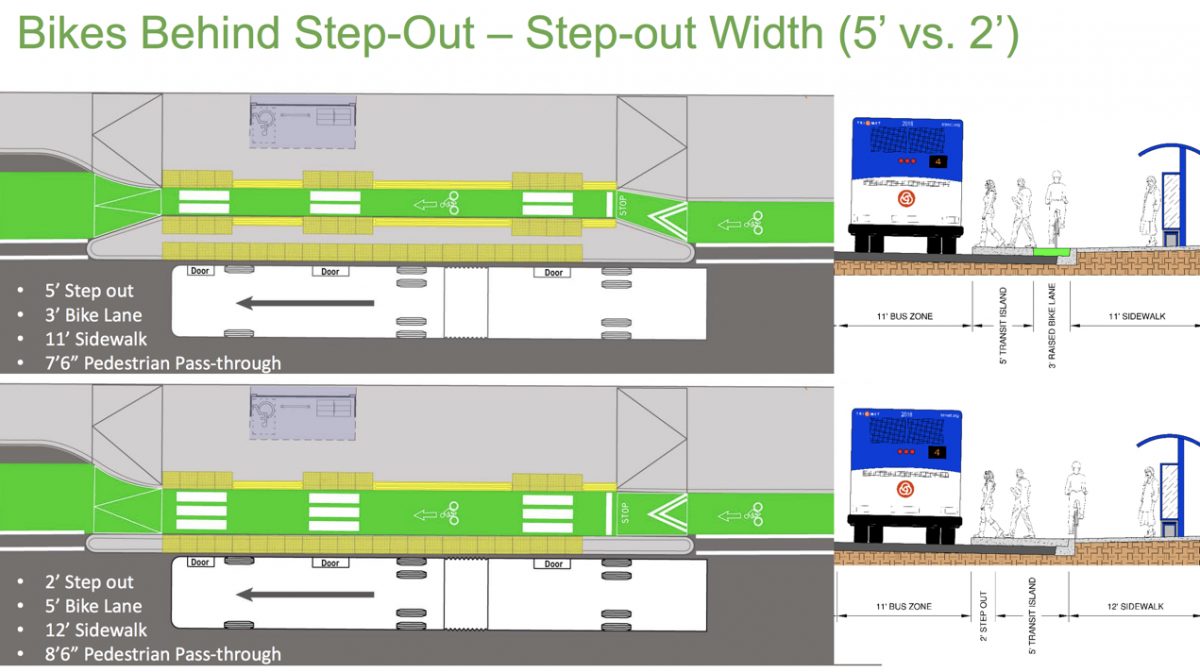
Here’s another graphic that was shown to the committees last night. It’s an animation that depicts the intended movements of different users:
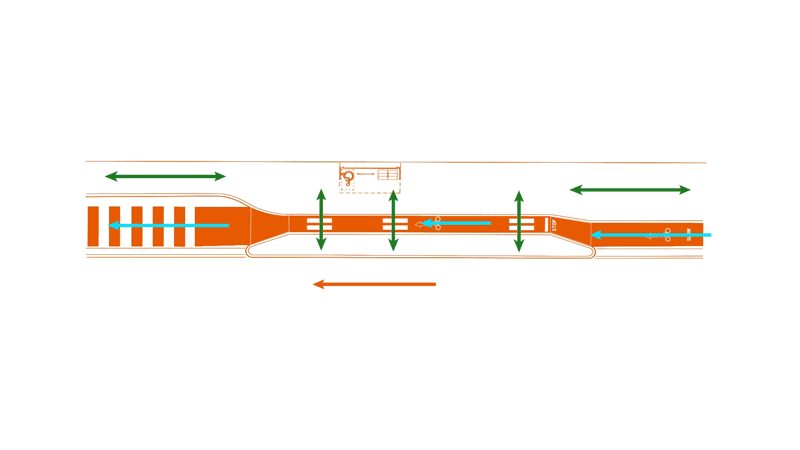
— Jonathan Maus: (503) 706-8804, @jonathan_maus on Twitter and jonathan@bikeportland.org
Never miss a story. Sign-up for the daily BP Headlines email.
BikePortland needs your support.



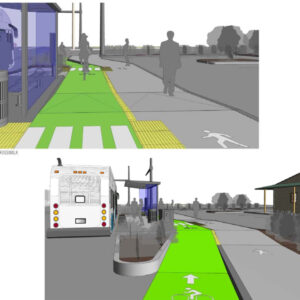
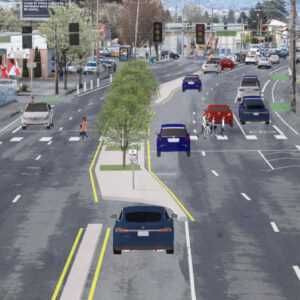
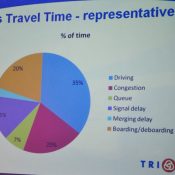
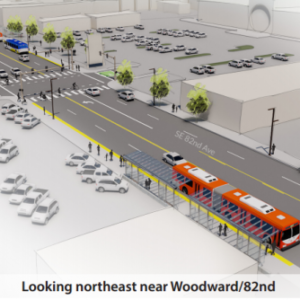
Thanks for reading.
BikePortland has served this community with independent community journalism since 2005. We rely on subscriptions from readers like you to survive. Your financial support is vital in keeping this valuable resource alive and well.
Please subscribe today to strengthen and expand our work.
Can’t help but notice that a plastic “delineator wand” (or whatever we’re calling them now) is knocked down in that last image, yet years of research were necessary to figure out that they’re wasted money.
On a two-way street, there aren’t many options for people on bikes: unpopular (central bike lanes), vehicular (bus crosses lane), and protected (bus passengers cross bike lane). If it must be the latter, then you’ve got to slow bicycle traffic near transit users.
I will say that the skinny lane needs to be indicated by more than a surface treatment. A narrow, upward-sloping platform would be accessible, speed boarding, discourage its use as a waiting area, and not be so bad to accidentally roll onto as a bus driver or bicycle rider. Those photographs show a bike lane interrupted by a loading zone.
Impatient cyclists (that’s a euphemism) will go out into traffic while the bus is loading/unloading while impatient drivers (euphemism again) are also aggressively passing the bus. Collisions and serious bodily harm, and death will happen. Or… an impatient (there it is again, pick your foul body part) cyclist will be overestimate his (we know it will be a him) abilities and attempt to slalom through the passengers and a small child or person with mobility issues will get hurt. The national reputation of Canada is politeness. Not so much here in ‘Murica, we’re all entitled mavericks, just like Tom Cruise and Sarah Palin, even us cyclists. We, as cyclists and ‘Muricans need to change that. We are all just people trying to get someplace. Commuting and running errands is not a race. Don’t be an impatient cyclist. Infrastructure improvements alone help immensely but aren’t the whole solution.
Honestly I would be more likely to just move out into the lane and avoid it all together when a bus IS NOT present. When a bus is there it’s not much different than current… just sit and wait till it’s gone, either out in street behind bus or in bike lane at end of “platform”. Bus would likely clear sooner than people walking through this space so in either situation I would expect more confident (unlike you I have no knowledge of their mental state regarding patience) riders merging out into the lane.
So main advantage here is that bus does not have to cross over bike lane. Impact to bikes is about neutral, if slightly negative when a bus is not present. Impact to peds I would guess is neutral as now they have to travel through bike lane rather than the bus blocking it for them but maybe more consistent loading gap between bus and curb? And more space to wait for the bus.
Don’t run any bike lanes through bus loading and unloading zones. That’s just plain stupid.
Period.
How would you redesign it?
I really don’t know, but I do know stupid when I see it.
Try to think about it. Trimet is offering to do these citywide, according to the article.
Buzz, I’m not trying to put you or anyone else on the spot. I really want to know how it should best be fixed.
To start, here’s two related street profile tools, Streetmix and Streetsketch. I’ve created profiles for Division near 122nd based upon their current layout. If I have anything wrong, I’m sure someone like Paikala will let me know. The tools are fairly intuitive – I encourage you to experiment!
https://streetmix.net/-/708883
http://streetsketch.mobycon.nl/-/4493
I included both versions as the Dutch version has some tools not available in the USA.
Maybe run the bike lane on the outside of the bus loading zone, so there’s no conflict between bus riders and bikes?
That’s what we have now, and people complain about that: busses merging through the bike lane, blocking the bike lane, etc.
I don’t. Besides, I’d rather have one professional driver crossing the bike lane than dozens of distracted pedestrians stepping off a bus, not necessarily expecting bikes to be whizzing by between them and the sidewalk.
That is the difference in a nutshell. Would you rather be at risk of death with cars/buses traveling at 25+, or be forced to slow or even stop occasionally when a bus happens to drop off people as you pass? Which design would you want to ride with your kid?
I think it’s an exaggeration to say “risk of death” in this case.
You’re right, no cyclists have ever died on outer Division. We should not be concerned about mixing in with heavy truck traffic and “late for work” commuters.
How many cyclists have ever been killed or let alone even hit by a bus approaching a stop?
Not mixing in; big buffered bike lane.
Chris, there was a high-profile case of a cyclist killed by a drunk driver at 87th and Division a few years ago. However, there are usually on any given year several pedestrian deaths on outer Division, as there are far more pedestrians than cyclists in this part of town.
The “STOP” marking on the pavement where the pedestrian crossing zone (aka passenger waiting area) ensures that PPB can blame the cyclist for anything that happens at the bus loading area.
There’s absolutely no excuse for colliding with a ped at a place like this — it’s not like it’s not obvious when peds are close enough to cross.
I don’t see why cyclists riding around a stopped bus would be a problem — it’s just like passing a bus anywhere else. If you can’t figure out when it’s safe to change lanes and perform a pass, you’ll get in trouble everywhere, not just at bus stops.
A 10 year old cycling to school should merge into the left lane in order to pass a bus on outer SE Glisan or Division?
The kid should do anything he or she feels comfortable doing, including stopping for the bus like they’re supposed to — something anyone wanting to change lanes when it wasn’t clear would have to do.
Any kid capable of handling the rest of the road won’t have difficulty figuring out how to deal with a bus as this is nothing compared to the entrances/exits to many business locations as well as intersections to contend with.
Not sure what’s motivating your question. You consistently support ignoring traffic controls and object to suggestions anyone follow basic safety procedure. I suggested treating the stopped bus like you would any other vehicle anywhere else in town. It’s not complicated stuff.
Happily the kids I see riding use good sense. Generally speaking, the teenage to middle aged males seem to have the most difficulty figuring out how to handle basic situations.
I don’t think so… the bus would cross the bike lane into a “station” when safe to do so; cyclists, including the 10 year old child riding on outer Division, would remain in their lane, without merging with anyone. I’m not sure what merging Kyle was referring to.
I was suggesting not stopping and going around the bus like I would anywhere else. I feel no obligation to use bike infrastructure that directs everyone into a conflict point when there is an easy common sense alternative that avoids the conflict, is faster, and doesn’t inconvenience anyone else. People not feeling comfortable doing this can stop.
Not sure why we are trying to re-invent the wheel.
Let’s try again…
Bus/Streetcar stop under the tram
FYI, you seem to be linking to South Portland.
I’m going to assume you didn’t mean somewhere with endless mode conflicts and backups at the smallest queue to cross Moody.
Indeed I am, Champs. And thank you for taking the time to figure out what I was trying to communicate; I should learn how to internet sometime…
I’m referring to the specific design problem TriMet is looking for feedback on for the Division project: bus-bike interactions at bus stops. I point out the Moody & Gibbs example for its cross section at the transit stop itself (bikes behind a full station, not putting bikes through the middle of a transit stop), not the complex intersection just to the south.
I think this is where you mean: https://goo.gl/maps/6fxM7pJrSZ52
It has the bike lane, then the transit wait area, then the bus travel lane. Ped cross when they can, then they all load at once with very minimal impact to cyclists. The unloading passengers would be the only ones crossing in a herd.
It certainly seems like the bike “stop” should be a “yield” instead. The majority of the time bikes will have no conflict with pedestrians and there is no visibility problem. This seems to be a design that’s strongly encouraging people on bikes to break the law.
We don’t make cars stop every time they cross a pedestrian crossing. Why the double-standard?
Anyone asked Vancouver, BC, how their version works?
https://goo.gl/maps/QJmXJtqgn5w
It probably works great when there are no bus riders present, just like in the image you posted.
You should visit and see for yourself.
This is not what is proposed for Division. For one, on the blocks where there is parking at all, there are only four spots, so cyclists are not blocked from driver’s vision before making a turn. Given the driveways on Division, how will visibility be preserved?
Few cyclists will even know there’s anything painted and probably over 95% of the ones that do won’t heed it.
Given that the vast majority of cyclists ignore both the red lights and the indications to stop on ground when peds have the right of way on BN, I seriously doubt many cyclists will stop here even when peds are present.
As with BN, I expect peds will learn to cross with caution and yield to cycles crossing against the light while those they dodge complain about how terrorized they feel.
Would YOU stop here if there was nobody present?
I don’t think it has anything to do with red lights.
I do slow to a less than walking pace even if I see no one — specifically to make sure that no cyclists are approaching at speed to enter/cross BN as is common at Pine though this can happen anywhere.
Some crosswalks seem to almost always have people. Neither cyclists nor peds crossing with the light should need to yield, and too often I see exactly that. Peds also have right of way at any crosswalk, marked or unmarked on any street. So few cyclists seem to yield with a comfortable buffer that an surprising percentage of peds, especially those with kids, verbally thank me (i.e. not just a friendly nod or wave) .
I think that the shelter should be on the platform, not a bike-lane away. Like the street car stops on Moody. It’s easy enough to yield to pedestrians on their way to the shelter, but much harder to guess when everyone is going to spot the bus coming and bounce out of it.
Also, there should be a crosswalk behind the bus so transit users can access the stop from the other side of the street. It’s dumb to make pedestrians cross the bike lane twice like some weird maze.
I agree with other posters that a ‘stop’ here is not needed; yield will do. At most, a “stop when bus is present” is needed.
Erm, one other thing: This is not rapid transit unless they build an overpass (or under?) across the railroad. Having 60′ busses stuck waiting — for whatever UP likes to do with their 5mph trains during rush hour — is a waste of time & money. They should have made the streetcar overpass able to take busses too, but they didn’t; so now this will cost a lot more. I don’t know if the streetcar overpass could be upgraded for busses now, or if it’d require a whole new structure. If they do need to build a NEW overpass, it’d be a missed opportunity to not include bike lanes.
What’s the point of having separate bus and bike lanes if cyclists have to stop when a bus is present anyway?
A lot of cities combine busses and bikes in one shared car-restricted lane. It’s even in the NACTO manual, but for some reason TriMet refuses to even consider the idea; they still won’t even allow bikes in the bus lanes on the downtown bus mall. More stupid from PBOT and TriMet.
I was just in the Netherlands for a few days last week and the bus stops/protected bike lanes outside my window actually looked exactly like this. They seemed to work well with no problems as far as I could tell.
Europe is not the USA, esp. the Netherlands.
You’re right. We kill our traveling public at 5-10x the rate of the European countries. We’re even getting pretty good at killing dutch citizens, as well:
https://www.oregonlive.com/pacific-northwest-news/index.ssf/2018/06/3_dutch_workers_killed_in_sale.html
Hit from behind by a distracted driver in an oversized pickup (F350).
Bingo. People on here don’t seem to like new, different things, though.
Not everything new is actually better, and where traffic is concerned, old, boring, and predictable is generally preferable to new, exciting, and interesting.
Why are all the zany designs reserved for cyclists?
I think Ben is saying this has been standard practice/design for 30+ years in many other countries. There is nothing “new” or “zany” about this. It’s simply “new” in the US.
On the other hand Tri-Met is proposing to split the bus stop into a waiting and loading zone. Combining these zones and separating with a rail would be a little closer to standard designs used elsewhere.
Yes, these bus stop bypasses are quite common here in the Netherlands. But there is one notable difference to the design proposed here. When there is a waiting area between the separated cycle path and the road, cyclists have priority over the pedestrians that need to cross the cycle path. If the design is more like drawing 2, then I think the cyclists have to yield. But I don’t recall seeing such an example anywhere, as the other case is the standard Dutch design. In Denmark, there’s usually not a waiting area and then the cyclists have to yield
My overall point is this, let’s not be too gullible to whatever BS PBOT and TriMet feed us; that’s been proven time and time again to not be in cyclists’ best interests.
Note that I’m not mentioning ODOT here, because they are in a league by themselves…
I’m really disappointed that TriMet is abandoning the plans for true floating bus stops. Although uncommon in Portland, it’s a tried and tested design, in use in many other cities.
What they’re now proposing is a compromise that sets up conflicts between bicyclists and transit riders. The new bus service on Division won’t automatically call at every station, so transit riders will want to wait at the curb, and not 8′ plus back as intended by this design. With limited width in the island we’re likely to see people standing in the bike lane. Whenever a bus is at the station bike riders are supposed to stop behind the station, which eliminates one of the major advantages of floating bus stops. I imagine compliance with that will be pretty low. This can only work well if either bus or bicycle usage is low; hopefully they’re not planning on either.
The reason TriMet staff gave to the BAC/PAC tonight for the change is that they want to reduce the amount of property it is necessary for them to buy at the stations. When I heard this couldn’t work out why they needed to buy any property at all. Outer Division is typically 90′ wide, with 7′ wide sidewalks. That leaves 76′ clear curb-to-curb. Given that the (little used) parking is being removed, should be plenty room for the five existing vehicle lanes, plus protected bike lanes and floating bus stops either side of the intersection. I mocked this up in streetmix:
I took me a while of searching through previous Bike Portland coverage to work out why something like the design above wouldn’t work. At its major intersections Outer Division goes up to six lanes: two through lanes in each direction, plus dedicated left and right turn lanes. The illustrations from last year showed they were planning on keeping that configuration, and getting the necessary width for the bus stops from the adjacent properties. That’s an expensive choice. It’s also a choice that makes the already long crossing distances for pedestrians even longer.
What’s obvious is that this project is trying very hard to maintain existing auto capacity, and when a budget crunch came the decision was made to compromise the design for bicyclists and pedestrians.
Here’s the link to the streetmix that I tried to embed in the above comment:
https://imgur.com/2v7LfPH
Gasp! Removing even unused or seldom used parking might need the political oomph Portland does not have. The streetmix image makes absolute sense.
As a bus driver who regularly drives the 4, I can tell you this design is wildly impractical for a number of reasons.
Most obvious being that intending passengers are highly inclined to want to watch for their bus to ensure it is on it’s way and stops for them.
In practice this means people want to wait as close to the curb as possible to see down the street. They plant their wheelchair, bags of cans, strollers, shopping trollys and whatever else they have curbside and gaze down the road. Such a design may work just fine in Canada but as much as I wish it was so, we are not so orderly.
TriMet’s willingness to hobble this project, for fear of causing congestion, is a sad and transparent admission of premature failure for the Division project and transit as a whole in 2018.
Totally agree with this. That was my first thought too.
No stop sign. Rails on the Moody street car stop are very helpful and may be justified at the busier stops.
How will transit riders standing/ clumping in the bike lane be addressed?
Check out this video for a more refined solution: https://www.youtube.com/watch?v=2Pvhkx0153k
Pretty cool.
UPDATE 6/13: Here’s one of the key slides shown last night. TriMet is trying to figure out which design to go with: A narrower “alighting area”/step out and straight/wider bike lane, or a narrower bike lane that jogs (and requires cutting into existing curb) around a larger step out zone:
I’m trying to figure out how I maneuver my tandem with a trailer that is wider than two feet into that two-foot option. Shall we next make travel lanes five feet wide with curbs on each side so people on motor vehicles can experience the joys of these notions? They can always purchase smaller vehicles, after all.
In the narrower option, the bike lane would be 3 feet and the alighting area would be 2 feet. There would be no physical barrier between the sidewalk, the alighting area and the bike lane for that 60 feet, it would all be at the same grade. Point taken though. Members of the BAC did bring up how narrow this would be for cargo bikes, etc.
In the end, the BAC’s objections will either be ignored or BAC will end up rubber-stamping whatever insane design is ultimately decreed by PBOT and TriMet management.
I’m surprised no one brought up that trikes couldn’t get through. They are frequently used by the elderly, those with disabilities, and others who simply like to ride trikes.
But in all fairness, if the gaps aren’t narrow, you know many cyclists will cut through fast. Every day on the bridges, I see people blowing by peds at over 20mph which is absolutely ridiculous. And while many motorists fail to stop for cyclists at crosswalks, rates of compliance for cyclists doing this are WAY less.
Lower option looks more practical. Simpler to construct, standard width bike lane, larger main portion of sidewalk… And before people criticize me for just liking that bikes can move through it more efficiently I will add that the smaller “boarding” width will hopefully keep people from standing out on it and crossing bike lane when a bus is not there, which will be the situation the vast majority of the time.
This design could also be exactly the same for stops along routes that have parking protected bike lanes where there is a larger boarding island in the parking lane.
It seems more than a bit awful to purposely set up narrow passages that create conflicts between bus riders/pedestrians and people on bikes. Other options should be put into play like taking advantage of the fact that these BRT buses have doors on both sides. Just put the bus stops/bus lanes on the left side of the road and the conflicts disappear.
It’s also galling that Trimet is using our current overuse of single-occupancy vehicles to justify doing a poor job. Their goal should be to reduce car use, which means using that other part of induced demand and removing travel lanes. Failing to do that will keep car counts at their current silly-high level.
We really can’t simultaneously achieve a reduced-car city and build for current car use levels. Something has to give, and that thing should be motorist convenience, otherwise it feeds the cynical view that our elected officials and staff are just gas-lighting us with their talk of prioritizing walking, cycling and transit.
Overall this is splitting hairs when the real issue remains unwillingness to do anything about car volumes.
Actually, ever since the new speed limits went in, traffic volumes have dropped dramatically – they used to be 30,000 to 40,000 vehicles per day, but are now 13,000 to 17,000 – almost within the threshold for a 3-lane road diet.
https://pdx.maps.arcgis.com/apps/webappviewer/index.html?id=7ce8d1f5053141f1bc0f5bd7905351e6
Am I the only one reading this with super-high eyebrows?! Doesn’t make sense.
Care to elaborate?
IMO, and I could be wrong, but I think that as long as drivers perceived outer Division as an expressway with virtually unlimited speeds between I-205 and Gresham, they used it as such. Now that PBOT has put in much lower speed limits AND speed cameras, drivers now perceive the roadway as being more “local”. The drop in traffic probably reflects the actual local street traffic, while the long-time pass-through drivers have since found faster alternatives, such as SE Stark, NE Glisan, SE Foster, or even I-84, which is what they should have been using in the first place.
Given the wide right-of-way, now might be a good time to advocate for some new lane configurations for outer Division. For example, anywhere traffic has dropped below 15,000 vehicles daily (82nd to I-205; 136th to 162nd), I’d suggest a 3-lane road diet for cars and dedicated bus-only lanes on the right lanes. For the parts with 15,000 to 20,000 vehicles, perhaps shared bus and right hand turn lanes?
By making outer Division non-consistent in its configuration, pass-through motorists will be even less inclined to use Division and seek alternatives, further reducing traffic and maybe allowing for even lower speed limits and slower actual 85th percentile speeds.
Both of these are poor designs. You need to put the bus shelter next to the bus lane. Otherwise you have large surges of people getting on and off the bus and completely blocking the bike lane. A shelter and diffusion area will help as the waiting passengers cross the bike lane at their own pace, and arriving passengers can diffuse near the shelter before crossing either the bike lane OR the street (but not both).
A stop sign for bikes at every shelter? Fire that person.
A 3′ wide bike lane? Fire that person.
TriMet seems to have a serious issue in their design department and something needs to change. They can re-org or just clean house, but they better do something. These laughable designs serve nobody. These designs are embarrassing and they should be ashamed.
Here’s another graphic that was shown to the committees last night. It’s an animation that depicts the intended movements of different users:
This animation omits what the cyclists do when they arrive at the station and there is no bus. Are they expected to stop?
Technically that’s still up in the air, according to planners. But it’s assumed that when buses are not present, bicycle riders will not stop. And FWIW some people think that’s one reason the pavement marking should be a “YIELD” instead of a “STOP”.
Of course they won’t. But I have to strenuously object (not to you personally) to the idea of installing traffic controls with the hope that people won’t follow them when they don’t make sense.
I find this whole design second rate.
Actually, the graphic shows two cyclists passing through the lane (tiny blue dots) as the bus is pulling in. There are two other blue dots that stop for loading passengers.
Not only do they stop for passengers, but they stay stopped long after the way forward is clear. The animation suggests bikes would be stopped until the bus left the station.
If you time it right, you can come to a stop every time the bus does.
Someone with animation skills should rework this to show how it would actually work in real life.
I would like the complicated, messy space where the transit waiting zone and the narrowed bike lane is, to simply be a big pullout for the bus.
Have the buses pull over into the pullout to load/unload passengers, and bikes can pass the bus on the left with no bike/ped conflict.
I am not worried about bus/bike conflict when the bus is pulling in/out of the pullout. Trimet drivers are more careful around bikes than any other class of driver in the city, and for cyclists it is obvious when a bus is going to pull over to or leave a bus stop.
If we are worried that bus drivers might not pull over fully, i.e. leave half the bus blocking the traffic lane, then make the pullout longer and put a bit of thin curb separating the central length of the pullout and the traffic lane, so that failure to pull over full will mean driving over the curb.
There aren’t any bus pullouts proposed.
I’m saying that there should be pullouts instead of this design. Big, long pullouts with enough room that busses can fully pull out of the traffic lane.
In addition to avoiding the bike/bus passenger conflict, pullouts would allow bikes to keep going instead of stopping for every bus.
I like your idea of creating some sort of structure that requires the buses to not block the bike lane.
Big long pull outs eliminate the most parking spaces, and that’s usually a non-starter in this town.
They also add delay to buses.
Only when drivers fail to yield as required… which is, admittedly, a frequent occurrence.
In which case adding bus pullouts would require additional ROW, to accommodate the pullout, sidewalk and bike lane. And if that additional right-of-way is available again, why not do floating bus islands instead of recreating the experience at SW Madison approaching the Hawthorne Bridge?
This works great at the pullout on the east side of eastbound Hawthorne. Lots of bicycles and buses crossing each other’s paths. The peds get to stay safely on the sidewalk.
https://goo.gl/maps/BjxNzkhy4xJ2
The issue is that they don’t want to take that much space away from drivers or property owners. Seems like an easy solution to dedicate a lane on Division for buses.
This is actually one of my least favorite bus stops as you do get stuck behind buses and will need to be careful of them pulling out. The proposed station design above with the wider island for bus users seems like a far better solution.
This is not too bad and is a step in the right direction however in my opinion it needs a bit of tweaking.
The general idea is good but it would be better if the island was wider and the bus shelter was on it.
In Vancouver, BC there is the first ever one of these on Dunsmuir Street. It works okay but you cross the bike path to get to the bus from the shelter. No big deal but it would be better if the bike path went behind the bus shelter. (There was an adjustment period where people took a bit to get used to it.)
https://flic.kr/p/8PE7AZ
Here’s one done later. Cornwall St. near Burrard. There was no adjustment period needed (that I’m aware of.)
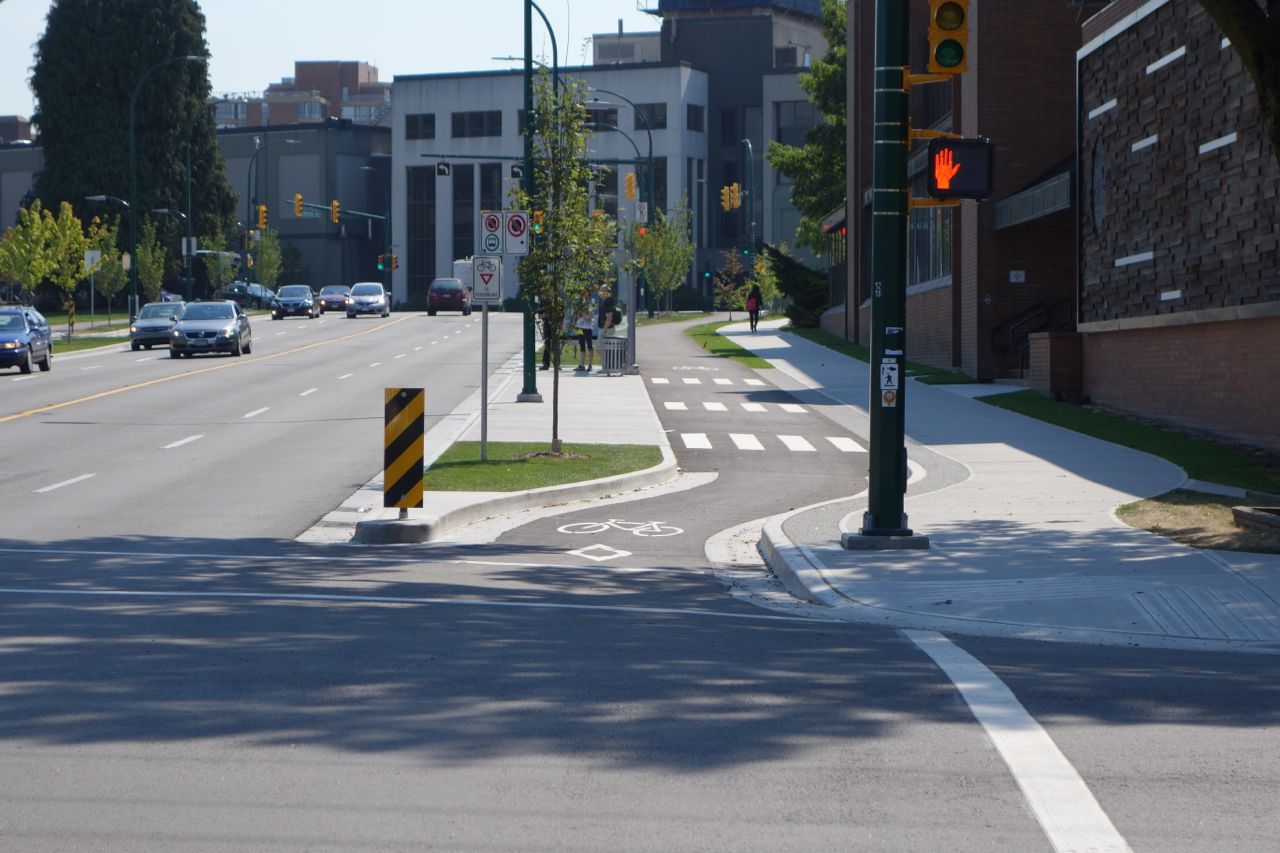
There should not be a stop sign, only a Yield to pedestrians sign. In between buses when nobody is there, having to stop for no good reason just teaches people to ignore stop signs.
Looks like the bike lane by that Cornwall stop is about 5 – 6′ wide; that’s at least twice as wide as TriMet is proposing…
This is pathetic. I was on the SC for this project. This is nothing like what LPA looked like. They say 15 to 20 percent reduction in travel time, but how will that happen when they will have to deploy a ramp for people with mobility devises, carts or stroller/kids. The bike lane design is ridiculous. Cyclists will assuredly try to go through while people are trying to get on or off, or they will go around the bus. Neither situation is safe or desired. Also where is the weather protection for people and other amenities? I also want to note that this design is in East Portland, so inner East Division will get regular platforfs with level or near level boarding and we will get the opportunity to walk into a bike lane.
I attended the meeting last night and a few comments/questions stood out to me:
1. A BAC member suggested testing some of these proposed design ideas at existing transit stops around Portland to get a real-world feel for how they would work. Couldn’t agree more.
2. Another committee member made an interesting point that while re-designing Division is important, these design changes are potentially asking transit users, pedestrians, and cyclists to abide by a different set of rules and norms than in the rest of Portland. I think this speaks to the comment made by the other committee member that testing some of these changes is important. The presenters mentioned a lot about how they observed real-world behavior and patterns in a lot of other cities, so why not see how they might work in Portland first?
3. Someone sitting next to me mentioned to me that if he were a cyclist he would avoid Division altogether if he were expected to stop so frequently. Food for thought.
Good luck about not using Division. If it were that easy, East Portland wouldn’t be in the mess it is. Clearly the speaker you spoke with has no idea that continuous parallel streets simply do not exist east of 82nd.
PBOT is intent on building out 1,000 new and different ‘experimental’ bike way designs instead of just making better use of what already exists in the NACTO design manual, such as sharrows and shared bus-bike lanes.
References:
https://www.citylab.com/transportation/2015/05/toward-the-peaceful-coexistence-of-buses-and-bikes/394217/
http://www.aviewfromthecyclepath.com/2013/08/ten-bus-stop-bypasses-for-bicycles.html
https://www.cycling-embassy.org.uk/dictionary/floating-bus-stop
https://peopleforbikes.org/blog/floating-bus-stops-made-plastic-panels-hit-street-oakland/
http://www.transportforall.org.uk/about/news/tfl-stop-building-floating-bus-stops-until-safety-concerns-are-dealt-with
And if a picture is worth a 1,000 words, here’s video:
https://www.ask.com/youtube?q=floating bus stop&v=hY7m5jjJ9mM&o=0&l=dir&qo=saLink
Your links all seem to show a sufficiently wide area between the bike lane and where the bus stops. In most cases it shows a full shelter there.
That’s what TriMet was proposing last year, but unfortunately isn’t proposing any more.
Thanks Paikiala! From the Citylab report:
“One potential problem with the floating bus stop design, at least when initially introduced into a city with no previous experience of the concept, is the conflict with pedestrians who are entering or exiting buses and must cross the bike lane to get to and from the stop. The islands must be big enough to give transit passengers a comfortable place to stand, and the cycle path must be clearly demarcated by differing pavement heights and coloring. Curb cuts with textured surfaces can assist the visually impaired to navigate the situation.
“Once people get accustomed to the idea that there is a cycle lane running alongside a transit stop, they seem to adjust to the situation, and things flow smoothly for all users.”
I really dislike these options for all the various reasons that others have pointed out. However, one thing that could it make it somewhat palatable is if there were a barrier (low fence?) between the pedestrian waiting plaza and the bike lane, with very small gaps (the smallest allowable and still meet ADA requirements) for boarding/unboarding. When I was riding in Seattle last month on their protected cycle tracks through downtown, I was continually concerned a person was going to step out in front of me as they were waiting for the light to change at an intersection.
Now granted a barrier could simply just serve to trap people on the bike lane, which would also be pretty terrible.
Really should just remove at least one auto lane — I love (irony) how the projects don’t seem to account for the possibility that if this was a great, easy to use, functional design for ALL users the car volume could conceivably go down with the improvements, instead of up.
To avoid trapping people, you would put fences on both sides of the bike track, with gates that line up with one another so the only logical path would be to walk directly across the bikeway.
Even being a Platinum city, Portlanders would have to get used to this approach to biking and bus stops, so we should make it the most obvious and safest solution we can.
It should be a wider island with space enough for the shelter. That gives bus users a dedicated area to wait and the ability to easily see the bus coming. The bus island and sidewalk should be raised above the bike lane with the bike lane brightly colored to make it extremely obvious that that is a lane for bikers and no pedestrian should be standing there. Bikers should continue flowing and not stop—this will reenforce the idea that pedestrians are crossing a lane of traffic and need to look both ways.
All of this will treat bikers as if they are a mode of transporation that is meant to flow around the bus stop. Bus users will have their space to safely wait for the bus AND they will be reminded that crossing the bike lane is like crossing any other lane of traffic, they should look both ways and wait for a clearing.
It is preposterous that a 3′-wide bike lane would even be considered when Biketown’s own adaptive bikes are 4′ wide. So people with disabilities are just supposed to unexpectedly merge into automobile traffic while all other cyclists continue through the 3′ bike lane? Are they trying to kill folks with disabilities?
People waiting for a bus want to stand as close to the curb as possible because they want to ensure the bus stops for them. Design should be based around this predictable behavior.
Will the bus stop island be at standard curb height (bad), or raised an extra 2 inches to allow for TRUE level boarding (good)? It blows my mind that agencies will spend money rebuilding bus stops and not take the time to create true level boarding.
As far as I know, MUTCD has certain warrants required before placing a stop sign. I highly doubt the pedestrian volume at a bus stop meets that warrant.
BTW, this is what Boston is currently building
We already have this, Westbound on the Hawthorne viaduct. Bicycles mount the curb on a ramp, then swing right between the loading zone and sidewalk waiting area for the 4, 10, and 14 lines. The pale section of concrete was added about 2 years ago. I’ve been riding through here for 8 years at various times during the morning commute.
https://goo.gl/maps/ugkXfmVEEMK2
The old setup created a lot of conflict. Since they made the loading zone wider, it’s pretty ok. The wider loading zone means that if cyclists choose not to yield, the deboarding passengers have a refuge until they can cross the lane, rather than stepping off the bus and right into the bike lane. The problems I still observe are twofold:
1. Despite signage and good sense, many cyclists chose not to yield. That’s dangerous for bus passengers trying to board or deboard.
2. Passengers don’t understand that they have the right of way, or think they are being polite when they wave me through. I don’t always come to a complete stop here, but I slow down to a crawl and wait for folks to cross. I’ve often been gestured through by someone who presumably didn’t want to “inconvenience” me – if you deal with that enough, it becomes easier to just go than fight about it.
These two problems reinforce each other, of course, because people who are accustomed to bikes going through their right of way will wave cyclists through, and cyclists who are tired of fighting over ROW will start just going.
Based on that stop, I’d say wider boarding zones are better, but I also don’t want to get squeezed into a 3′ bike lane (and hat tip to the person upthread who mentioned accessible Biketown rides are 4′ wide). The signage also needs to be “yield” rather than “stop” because that’s what we actually want to happen.